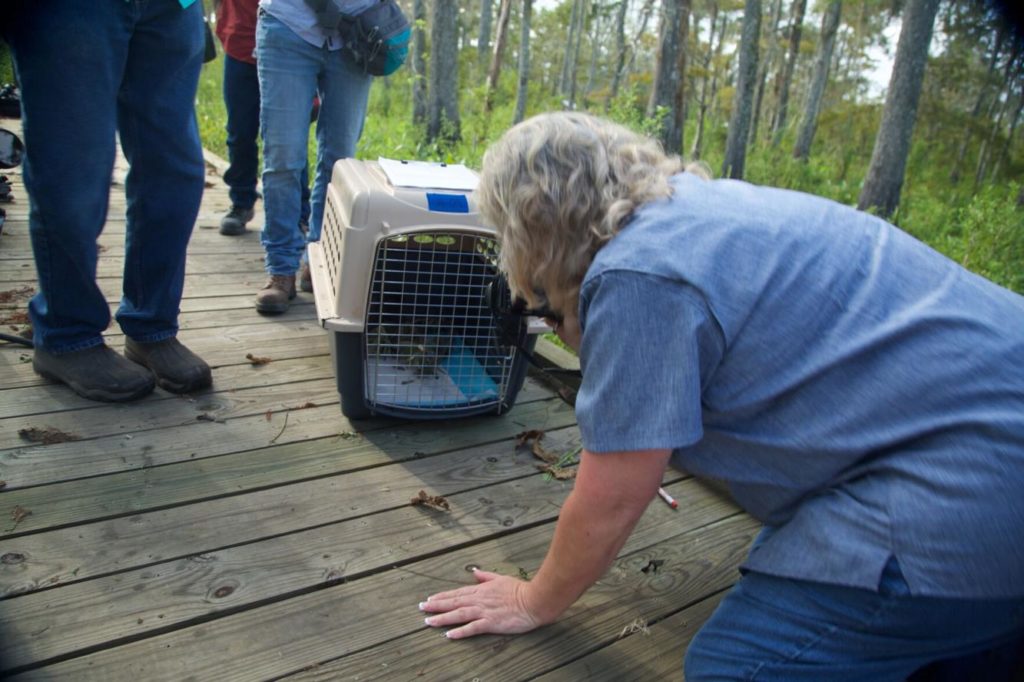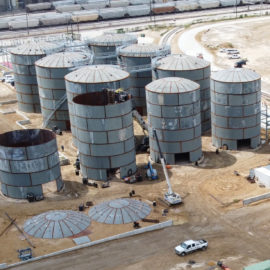
A wildlife rehabilitation specialist checks Thursday, Sept. 16, 2021, on two birds before releasing them at Bayou Teche National Wildlife Refuge. The birds were oiled during Hurricane Ida at the Phillips 66 refinery at Alliance, then captured, cleaned, rehabilitated and released.
LOUISIANA DEPARTMENT OF WILDLIFE AND FISHERIES PHOTO BY GABE GIFFIN
The levee broke at the Phillips Refinery and birds landing in the polluted water became oil soaked. They have been cleaned and released.
The first two birds cleaned and rehabilitated after being found oiled at the Phillips 66 refinery in Alliance as a result of Hurricane Ida flooding have been released back to the wild, the Louisiana Department of Wildlife and Fisheries said Friday. The purple gallinule and a king rail, both secretive birds that hide from predators under marsh vegetation, are among more than 100 oiled birds documented on or near the refinery after the Aug. 29 storm. They were released Thursday evening at the Bayou Teche National Wildlife Refuge in Franklin, the state agency said. Most of the oiled wildlife was originally spotted in heavy pockets of crude oil at the refinery campus, which flooded when a nearby levee failed during the Category 4 storm. Some also were found in nearby flooded fields and detention ponds. The wildlife agency said it captured 34 birds and plans to retrieve more. In addition to gallinules and other types of rails, oiled wildlife included black-bellied whistling ducks, blue-winged teal, several species of egret, alligators and river otters. No efforts are being made to capture or treat wildlife other than birds.
nola.comhttps://www.nola.com/news/environment/article_4effa1a2-17e0-11ec-acb4-db8db993c280.html

LOUISIANA DEPARTMENT OF WILDLIFE AND FISHERIES PHOTO
These are just the first of many birds that will be cleaned and released. A levee broke here which means this was the only site with this specific problem.
Most of the oiled wildlife was originally spotted in heavy pockets of crude oil at the refinery campus, which flooded when a nearby levee failed during the Category 4 storm. Some also were found in nearby flooded fields and detention ponds. The wildlife agency said it captured 34 birds and plans to retrieve more. In addition to gallinules and other types of rails, oiled wildlife included black-bellied whistling ducks, blue-winged teal, several species of egret, alligators and river otters. No efforts are being made to capture or treat wildlife other than birds. The wildlife agency said birds are first examined in the field and have their eyes and beaks washed and obvious obstructions cleared, if necessary. Once a bird is determined to be stable, it is put in a dark ventilated carrier and taken to a rehabilitation center in New Iberia for additional evaluations to develop individual treatment plans. When a bird shows noticeable improvement and exhibits normal behavior, it undergoes a final assessment before the wildlife agency approves it for release. The state agency is working with the Louisiana Oil Spill Coordinator’s Office, U.S. Coast Guard, U.S. Fish & Wildlife Service and Phillips 66 refinery in the recovery process.

The Phillips refinery was put up for sale before Ida struck. It has not reopened yet, if it does.
The refinery’s Ida flooding occurred four days after the news media reported that Phillips 66 was putting the property up for sale as part of its carbon emissions reduction strategy. The company has not said how long it will take to repair the refinery and resume operations. It did not respond to a request for comment on Friday. On Sept. 9, the company notified the state Department of Environmental Quality that it planned to discharge an average 20,000 gallons per day of uncontaminated stormwater into a drainage ditch leading to the Wilkinson Canal west of the refinery. A day earlier, the company notified the U.S. Environmental Protection Agency and the state that it had experienced a “force majeure” event – a power supply interruption – on Aug. 13. That was 16 days before Ida and resulted in the release of hydrogen sulfide and refinery flaring that violated provisions of its 2005 federal consent decree governing air emissions. The company said its electricity problems began Aug. 4, when an Entergy Louisiana transformer tripped at one of two substations supplying the refinery. An Aug. 13 accident at the second substation caused the plant to shut down for more than a day. Efforts to determine the amount of emissions in that incident, which included five days of flaring, were then disrupted by Hurricane Ida, the company said.
Two down and many more to go. Glad that that this is being done.


